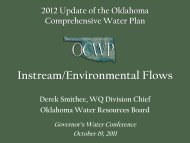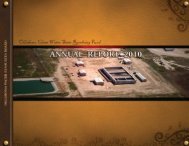Intended Use Plan for FY-2012 - Water Resources Board - State of ...
Intended Use Plan for FY-2012 - Water Resources Board - State of ...
Intended Use Plan for FY-2012 - Water Resources Board - State of ...
Create successful ePaper yourself
Turn your PDF publications into a flip-book with our unique Google optimized e-Paper software.
ATTACHMENT 22010 Clean <strong>Water</strong> and Drinking <strong>Water</strong> <strong>State</strong> Revolving Fund20% Green Project Reserve:Guidance <strong>for</strong> Determining Project EligibilityApril 21, 2010I. Introduction: The Fiscal Year (<strong>FY</strong>) 2010 Appropriation Law (P.L. 111-88) includedadditional requirements affecting both the Clean <strong>Water</strong> and the Drinking <strong>Water</strong> <strong>State</strong> RevolvingFund (SRF) programs. This attachment is included in the Procedures <strong>for</strong> Implementing CertainProvisions <strong>of</strong> EPA’s Fiscal Year 2010 Appropriation Affecting the Clean <strong>Water</strong> and Drinking<strong>Water</strong> <strong>State</strong> Revolving Fund Programs dated April 21, 2010. Because <strong>of</strong> differences in projecteligibility <strong>for</strong> each program, the Clean and Drinking <strong>Water</strong> SRFs have separate guidancedocuments that identify specific goals and eligibilities <strong>for</strong> green infrastructure, water and energyefficient improvements, and environmentally innovative activities. Part A includes the details <strong>for</strong>the Clean <strong>Water</strong> SRF program, and Part B the Drinking <strong>Water</strong> SRF program.Public Law 111-88 included the language “Provided, that <strong>for</strong> fiscal year 2010, to the extent thereare sufficient eligible project applications, not less than 20 percent <strong>of</strong> the funds made availableunder this title to each <strong>State</strong> <strong>for</strong> Clean <strong>Water</strong> <strong>State</strong> Revolving Fund capitalization grants and notless than 20 percent <strong>of</strong> the funds made available under this title to each <strong>State</strong> <strong>for</strong> Drinking <strong>Water</strong><strong>State</strong> Revolving Fund capitalization grants shall be used by the <strong>State</strong> <strong>for</strong> projects to addressgreen infrastructure, water or energy efficiency improvements, or other environmentallyinnovative activities.” These four categories <strong>of</strong> projects are the components <strong>of</strong> the Green ProjectReserve (GPR).II. GPR Goals: Congress‟ intent in enacting the GPR is to direct <strong>State</strong> investment practices inthe water sector to guide funding toward projects that utilize green or s<strong>of</strong>t-path practices tocomplement and augment hard or gray infrastructure, adopt practices that reduce theenvironmental footprint <strong>of</strong> water and wastewater treatment, collection, and distribution, helputilities adapt to climate change, enhance water and energy conservation, adopt more sustainablesolutions to wet weather flows, and promote innovative approaches to water managementproblems. Over time, GPR projects could enable utilities to take savings derived from reducingwater losses and energy consumption, and use them <strong>for</strong> public health and environmentalenhancement projects. Additionally, EPA expects that green projects will help the water sectorimprove the quality <strong>of</strong> water services without putting additional strain on the energy grid, and byreducing the volume <strong>of</strong> water lost every year.III. Background: EPA used an inclusive approach to determine what is and is not a „green‟ waterproject. Wherever possible, this guidance references existing consensus-based industry practicesto provide assistance in developing green projects. Input was solicited from <strong>State</strong>-EPA and EPA-Regional workgroups and the water sector. EPA staff also reviewed approaches promoted bygreen practice advocacy groups and water associations, and green infrastructure implemented byengineers and managers in the water sector. EPA also assessed existing „green‟ policies within4/21/2010 1


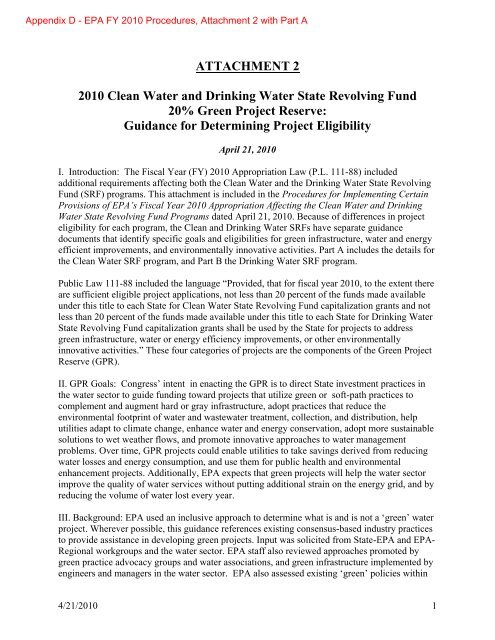


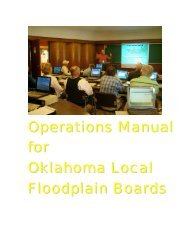
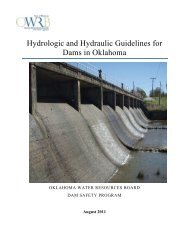
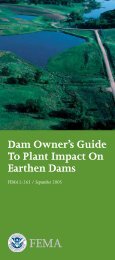

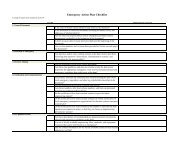



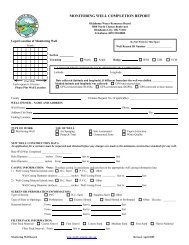
![A Commodity & a Resource [pdf] - Water Resources Board - State of ...](https://img.yumpu.com/42536671/1/190x143/a-commodity-a-resource-pdf-water-resources-board-state-of-.jpg?quality=85)
